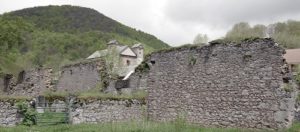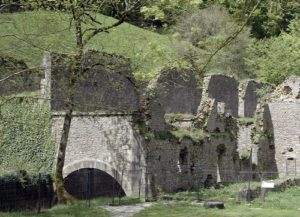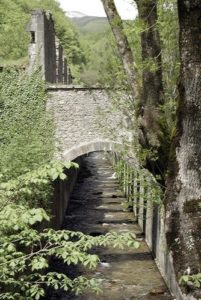I had read about this, seen the pictures on Google images and added it to the list. Michael wasn’t happy as on the map it looked a very isolated site in the mountains miles from anywhere along the sort of narrow road he dislikes when driving. He needn’t have worried. To our relief the road was much better than we expected. It was well maintained and graded and wide enough for two cars to pass easily, possibly as there was a lot of isolated farms spread along the valley.
Fabrica de Orbaitzeta is the site of a Royal Weapons and Ammunition Factory built on the orders of Carlos III in 1784 on the site of a 15thC ironworks. It is considered one of the finest examples of industrial architecture in Spain. It made cast iron bombs and supplied the casing for grenades and ammunition of various calibers. More than 150 people worked here using local deposits of iron. Charcoal to fire the furnaces was cut from local beech trees The trees were topped when they reached height of 2-3m. This encouraged the development of a lot of new growth which was cut every 10-15 years to make charcoal. Not only did this save having to fell mature trees, it also provided a supply of wood of uniform size.
The site was in use until 1873 and is now derelict apart from a new building in the main square and some of the workers cottages have been done up as second homes.
The site is built on four levels. At the top is the main square with Iglesia de la Immaculada at one end. This is late 18thC and a neoclassical design with small bell towers on either side of the west facade. In the centre is a doorway set in a portico with pillars and a triangle on the top. This is now used as a barn. Don’t go in as there is a guard dog kennelled in a corner. Beyond the church were terraced workers cottages.
In the centre of the square is the Palacio, a large two storey building with a small balcony. Between the Palacio and the church are the remains of the barrack blocks. Soldiers were stationed here as the area was subject to attacks from France. On the other side were more barrack blocks and the artillery detachment building, the inn used by the pack horse men and the bread ovens. Nothing remains of these and they have been replaced by a farm and outbuildings.
Below the square were the terraced workers houses along a cobbled street and reached by flights of steps. These were two storey building. At ether end of them were storage areas for iron ore. At the end of the street was the school and through a gate were the lavatories and vegetable gardens.
The workers cottages were built in two blocks. One has disappeared apart from the foundations. The other has been done up and now has a long balcony running the length of the first floor. This has a huge supply of fire wood beneath it.
Between the two blocks was the aqueduct from a stone lined water reservoir which held the water needed for the various hydraulic systems around the works. The water supply came from a dam further up the river. A stone lied channel took water into the works. Its outlet flow into the river below can still be seen from the road.
Below the workers cottages were the industrial buildings. There were two big smelting furnaces with the hydraulic buildings behind them. Upstream of this were the carpentry and locksmiths workshops and stores. Beyond was the large building housing the drop hammer. On the far side of this was the smaller Santa Barbara furnace and its drop hammer building. Downstream of the smelting furnaces were the clay moulding shops for the grenades and munitions as well as the cleaning and inspection rooms. By the road was the huge courtyard used to store the grenades and munitions until they could be taken away by pack horses to be filled.
On the other side of the river are the charcoal bunkers. Because of fire risk, these needed to be kept separate and away from the furnaces. Charcoal made in the forest was brought down by pack horse and stored here. Archways were built across the river so the charcoal could be moved to the top of the furnaces. The picture of the river and stone archways is one of the most common pictures of the site.
At the end of the charcoal bunkers by the road was the small graveyard, now hidden by long grass.
The external walls of most buildings still stand several feet high and it is possible to make out most of the buildings. There are a series of information boards around the site in Basque, Spanish, French and English. When we visited in mid May, the industrial buildings along the river were fenced off and not accessible.
The site is free and we found it a fascinating place. Parts of it would be difficult to access with a wheelchair but there are good views from the top where you park.
There is quite a bit of information on the web, so we went well prepared with map of the site and information. This paid dividends as it helped us understand what we could see. Coming from an iron and steel making background, Michael really enjoyed the visit and found plenty to photograph.










